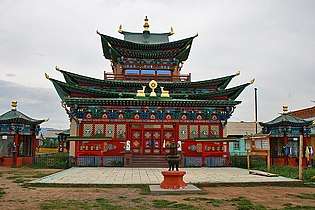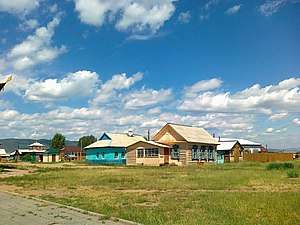Ivolginsky Datsan
Ivolginsky datsan (Russian: Иволгинский Дацан) is the Buddhist Temple located in Buryatia, Russia, 23 km from Ulan Ude, near Verkhnyaya Ivolga village.




History
The datsan was opened in 1945 as the only Buddhist spiritual centre of the USSR. In the course of time the little "Khambin's sume" changed into the Monastic centre with a residence of Pandido Khambo lama, the leader of all Russian Lamas.
It was the residence of the Central Spiritual Board of Buddhists of the USSR and later of the Buddhist Traditional Sangha of Russia, as well as that of Pandido Khambo lama, the head of the Russian Buddhists. The spiritual activity of the datsan is manifested in temple rites, medical practice, and a traditional system of Buddhist education. The Buddhist university «Dashi Choinkhorling» was opened in 1991 attached to the datsan.
Treasures of culture
Although built in the late 1940s with light-colored brick, the [main] temple displays traditional proportions and ornamentation. The first level is devoted to study and prayer. The second level preserves sacred texts. The third level, the gonkan, serves as an inner sanctum devoted to the guardian deities. The gonkan is surrounded by an open gallery to allow ceremonial processions around the sacred space.[1]
Unique samples of old Buryat art, as thangkas, sculptures, ritual objects are gathered and preserved at the Ivolginsky datsan. Among the monastery's treasures there is a collection of old Buddhist manuscripts written in Tibetan language on natural silk, and a greenhouse with a sacred Bodhi tree.
As a cultural and religious monument, the Datsan is protected by the State. The Datsan Centre consists of such temples as Sockshin-dugan, Maidrin-sume, Devazhin and Sakhiusan-sume. There are also a library, a hotel, the Choyra (Faculty of Philosophy), Dashi Choinhorlin (building of the Buddhist University), Museum of Buryat Art, suburgans (stupas), some infrastructure buildings and lamas' houses.
Within the Datsan complex is the Korean style wooden Etigel Khambin temple which honors the 12th Khambo Lama whose body was recently exhumed.[2]
Itigelov
In 1927, the 12th Pandito Hambo Lama of the Ivolginsky Datsan, Dashi-Dorzho Itigelov, told his students and fellow monks to bury his body after his death and to check on it again in 30 years. According to the story, Itigelov then sat in the lotus position, began chanting the prayer of death, and died, mid-meditation. The monks followed Itigilov's directions, but when they exhumed his body 30 years later, they were amazed to find none of the usual signs of decay and decomposition. On the contrary, Itigilov looked as if he had been dead only a few hours, rather than three decades. Fearful of the Soviet response to their "miracle", the monks reburied Itigilov's body in an unmarked grave.
Itigelov's story was not forgotten over the years and on September 11, 2002 the body was finally exhumed and transferred to Ivolginsky Datsan where it was closely examined by monks and by scientists and pathologists. The official statement was issued about the body – very well preserved, without any signs of decay, whole muscles and inner tissue, soft joints and skin. The interesting thing is that the body was never embalmed or mummified.
See also
| Wikimedia Commons has media related to Ivolginsky datsan. |
- Buddhist monasteries in Russia
- Buddhism in the Russian Federation
References
- "Ivolginsk Buddhist Datsan, with Main Temple (1940s), Ivolga, Russia". World Digital Library. 2014-03-25. Retrieved 2014-03-27.
- Trans-Siberian Railway. Lonely Planet. 2009. pp. 238–. ISBN 978-1-74104-135-4.
External links
- Photograph of Ivolginsk Buddhist Datsan, Main Temple, Interior, Ivolga, Russia
- (in English) Site of the Buruatian Ministry of Culture
- (in English) Ivolginsky datsan
- (in English) Hambo Lama Itigelov
- (in English) Hambo Lama Itigelov at the Buddhist Channel
- (in Russian) Official home page of the Ivolginsky datsan